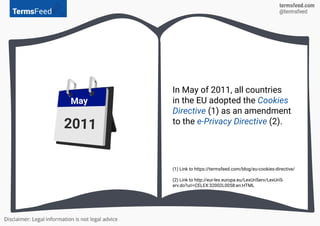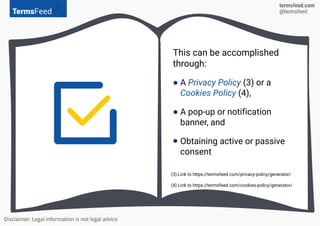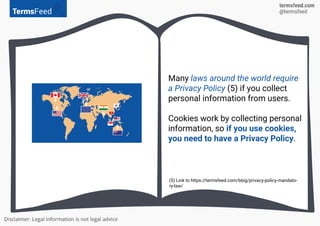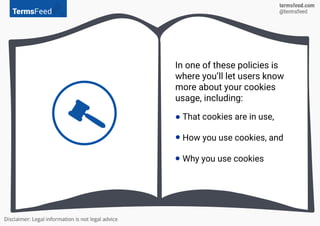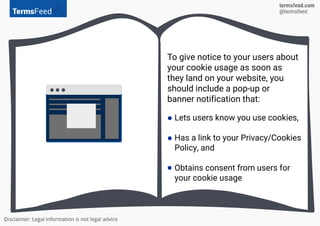EU Cookies Directive
- 2. In May of 2011, all countries in the EU adopted the Cookies Directive (1) as an amendment to the e-Privacy Directive (2). (1) Link to https://termsfeed.com/blog/eu-cookies-directive/ (2) Link to http://eur-lex.europa.eu/LexUriServ/LexUriS- erv.do?uri=CELEX:32002L0058:en:HTML
- 3. The EU Cookies Directive applies to all websites that use cookies that are either: Owned by an EU business, or Directed towards EU citizens
- 4. If you fall under its scope, you must inform visitors to your website: That cookies are in use, How you use cookies, Why you use cookies You must also obtain consent before you use cookies.
- 5. This can be accomplished through: A Privacy Policy (3) or a Cookies Policy (4), A pop-up or notification banner, and Obtaining active or passive consent (3) Link to https://termsfeed.com/privacy-policy/generator/ (4) Link to https://termsfeed.com/cookies-policy/generator/
- 6. A Privacy Policy or a Cookies Policy
- 7. Many laws around the world require a Privacy Policy (5) if you collect personal information from users. Cookies work by collecting personal information, so if you use cookies, you need to have a Privacy Policy. (5) Link to https://termsfeed.com/blog/privacy-policy-mandato- ry-law/
- 8. You can also choose to have a separate Cookies Policy that focuses solely on your use of Cookies.
- 9. In one of these policies is where you’ll let users know more about your cookies usage, including: That cookies are in use, How you use cookies, and Why you use cookies
- 11. To give notice to your users about your cookie usage as soon as they land on your website, you should include a pop-up or banner notification that: Lets users know you use cookies, Has a link to your Privacy/Cookies Policy, and Obtains consent from users for your cookie usage
- 14. Passive Consent
- 15. While it’s recommended to make users actively click something to show consent, some businesses take a more passive approach. This includes using a banner or notification that lets users know that by continuing to use the website, you agree to the use of cookies.
- 17. If you take the passive consent approach you need to make sure your notice: Is clearly visible and unmissable to a first time visitor Makes it clear to users that by continuing to browse your website, consent to place cookies will be implied Remains visible until the user does continue to browse
- 18. Exceptions to the Consent Requirement
- 19. You can use the following types of cookies without obtaining consent first: Cookies used solely to transmit a communication Cookies that are absolutely necessary in order to provide the service the user requests Examples of these cookies include user input cookies, multimedia content player cookies and authentication cookies. 1 2
- 20. To comply with the EU Cookies Directive: Have an informative Privacy Policy or Cookies Policy, Give notice through a banner or pop-up notification, Obtain consent before using cookies
- 21. These requirements are the minimum that all EU member countries must follow. Some countries have additional requirements, so make sure to check the rules and regulations for each EU country you do business in to make sure you’re staying compliant.


